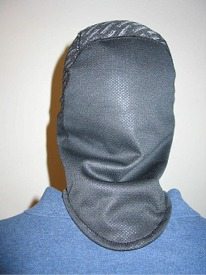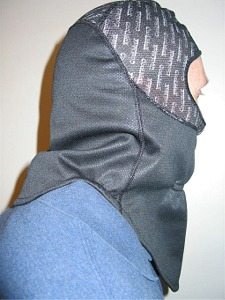Editor’s Note: A balaclava (aka balaclava helmet) is defined as “a cap that is close-fitting and woolen and covers all of the head but the face.”
I did some research to try and find the origin of the word, but to no avail. However, I did come across some interesting British history regarding the Battle of Balaclava during the Crimean war in 1854.
Apparently, knit wool Balaclava helmets were sent to the soldiers fighting that war by the folks back home. The Balaclava pattern has been used as a head covering for centuries, probably because it makes sense to cover the head and neck as a way to keep warm.
It’s a little late in the season here in the northern hemisphere to be thinking about Balaclavas for winter motorcycle riding, but don’t forget that our riding colleagues on the flip side of the 0th parallel are just about to begin their winter, so this one’s for you…
If you only ride in weather hot enough for jeans and a T-shirt, this article’s not going to interest you much. But for those year ’round riders like me that have trouble getting through a day or week without riding regardless of the outside temperature (or if you would simply like to extend your riding season into cooler weather) then you may want to continue reading.
Anyone who has been out in the cold on a windy day knows that without the proper clothing you can get really cold really fast. However, activities like skiing, hiking or chopping wood cause the body to produce heat, which makes it much easier to tolerate the cold with lighter clothing.
The problem occurs when we’re sitting on our motorcycles, riding in the cold and the wind. No activity means little extra body heat, and the heat that’s left is mostly being dissipated in vast quantities at a rapid rate with the head being the biggest contributor to the loss. Besides being bloody uncomfortable, it’s also dangerous!
If not prevented, hypothermia can quickly overcome the rider, depending on body weight, body mass, and road speed (aka wind chill). Two of the most common symptoms of hypothermia are slowed thoughts and slowed reflexes, both of which can be deadly while riding a motorcycle.
So it’s important to have good insulated gear, to dress in layers using good quality motorcycle wind blocking clothing, or to use some heated gear like the Gerbings heated jacket liner or the Chilli heated vest. I made the plunge a few years ago and bought Gerbing’s Ultimate Suit which works well for me.
It’s important to try different types of clothing to find a combination that will keep out all of the drafts that can creep in and defeat the many layers of clothing you’ve managed to pile on. The biggest source of drafty cold air is around the rider’s neck.
The air can travel right down your back and chill you to the bone, despite wearing enough clothing to look like the Michelin man’s long-lost twin brother. I can tell immediately whenever I don’t have things sealed up properly because the cold air seeps in like water through a broken seal.
The best solution I’ve found for keeping my neck and head warm is in the form of a Balaclava worn under my helmet. A good Balaclava fits over the entire head, leaving only the eyes or face uncovered. It should extend down over the neck and continue onto the chest and back for maximum protection.
I’ve been using one for the last few years that uses a material labeled as “Windtech” for the neck and thick spandex for the part that fits over the head. It is both stretchy and comfortable, but I still seemed to have a cold spot right across the base of my skull.
I hadn’t explored many other options until one cold day when I stopped by my dealer and got to talking with another cold weather rider. He said he’d found another product that cured that problem for him. It’s made by River Road and is of the same configuration as my Balaclava, although it’s constructed from different materials. Perfect!
I went back the next weekend and bought one, put it on and tried it out on the way home. I initially found it to be quite tight across my mouth. If I pulled it down to rest under my chin, when I moved my mouth it rode up over my lower jaw and got stuck across my mouth much like a horse’s bit.

My old noggin was quickly becoming chilly and my ears were also getting cold, even wearing a full-face helmet on a motorcycle with a full windscreen.
Once home, on closer inspection I noticed the fabric over the head is a thin but heavily perforated “Coolmax” material. That would explain why my head was getting so cold.
The material that covers the neck is claimed to be made of “comfortable fleece … windproof/breathable” and it seems to do a good job of blocking the wind, but the material does not extend far enough down into my jacket on the back to maintain a proper seal unless I keep my head still and don’t turn it from side to side (see photo, left).
I don’t know about you, but I’m continually moving my head back and forth as I scan for traffic and road hazards.
I laid the two balaclavas side by side and did some measuring. I found that the flaps were the same length at the front where they extend onto the chest, but the rear flap from the River Road product was a full 4 ½” shorter than my old Balaclava, thus explaining the easy loss of a seal at the back of the neck.
Conclusion
If you’re looking for a solution to keep your head and neck warm while riding in cool/cold weather, a Balaclava is probably the answer, but the River Road product comes up short in performance and insulation.
Although it claims to “protect head and neck from the cold wind”, my opinion is that the material used does very little to retain the heat in my head and the short flap on the back fails to keep cold air from streaming into the back of my jacket.
In my opinion, all it needs to be a great product is a warmer material over the head to hold in the heat, and about another 5″ added to the rear flap. It can also use a more flexible material over the mouth that provides some stretch, which would make it less confining and restrictive. Keep these tips in mind when you’re looking for your next Balaclava.
|
wBW Product Review: River Road Balaclava |
|
| Available From: River Road | Suggested Retail Price: $34.95 |
| Product Comments: Needs better insulating material over the head and a longer rear section to keep out the cold air. | |
Note: For informational use only. All material and photographs are Copyright © webWorld International, LLC – 2000-2011. All rights reserved. See the webBikeWorld® Site Info page. NOTE: Product specifications, features and details may change or differ from our descriptions. Always check before purchasing. Read the Terms and Conditions!
Owner Comments and Feedback
Not all comments will be published (details). Comments may be edited for clarity prior to publication.
From “J.A.” (4/10): “I personally won’t ride in less than 15C (50F) weather with out using my River Road balaclava under my SyMax 2 helmet (review), with a partial windscreen.
The coldest that I have ridden is 2F and while many parts were pretty cold my head was not one of them. The material does give enough to allow you to park the lower opening below your chin for a drink or snack and yet covers the chin and even the nose which is nice for really cold rides.
As to the back of the neck being occasionally exposed because the (tail) of the balaclava is shorter I have to agree with you that during a two hour ride I sometimes find that after moving around a bit in the saddle that the back has moved up enough to allow a cool breeze across my back, usually that is a good time to take a break anyhow.
All things considered I am still very satisfied with the value and performance of my River Road balaclava.”



